Acute unilateral blurred vision in a patient with a choroidal lesion
A subretinal mass, subretinal fluid and cystoid macular edema were observed in the left eye.
 Mark E. Patron |
 Andre J. Witkin |
A 52-year-old woman presented with complaints of blurred central vision in her left eye for 9 days and was referred to the New England Eye Center for evaluation.
She denied visual floaters or flashes. Her medical history was significant for cat-scratch disease 6 years ago and osteopenia. Medications included Actonel (risedronate, Procter & Gamble Pharmaceuticals), estradiol and norethindrone acetate.
Examination
On examination, the patient’s best corrected visual acuity was 20/20 in the right eye and 20/60 in the left eye with no improvement on pinhole. IOPs were 12 mm Hg in the right eye and 10 mm Hg in the left eye.
A temporal visual field defect was noted in the left eye. Pupillary exam was normal with no afferent pupillary defect. Anterior segment exam showed trace nuclear sclerosis of both lenses. Dilated funduscopic examination of the left eye showed 1+ anterior vitreous cell without vitreous haze, posterior cell or retinal vascular sheathing. The optic nerve was healthy, and retinal vasculature was of normal course and caliber.
A 12-mm elevated, reddish-orange subretinal mass was present nasal to the optic nerve (Figure 1). Retinal pigment epithelium hyperplasia and fine telangiectasias on the surface were noted overlying the lesion. Subretinal fluid overlying the lesion extended to the nasal boundary of the optic nerve. Mild cystoid macular edema (CME) was observed.
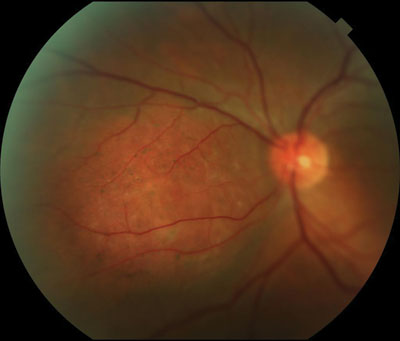 Figure 1. Fundus photograph of the left eye taken at initial presentation showed an elevated, orange-red colored choroidal mass nasal to the optic nerve. Images: Monson BK, Duker JS
|
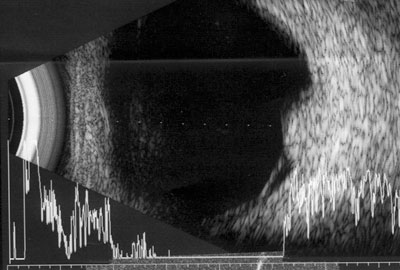 Figure 2. B-scan demonstrated a 4-mm elevation of a choroidal lesion with high internal reflectivity. |
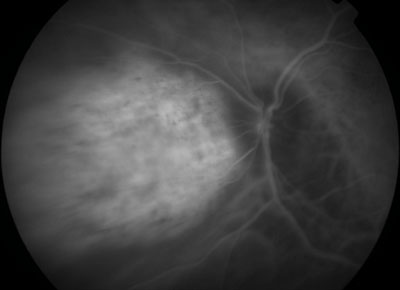 Figure 3. Indocyanine green angiography demonstrated a well-defined area of early (27.1 seconds), intense, uniform hyperfluorescence. |
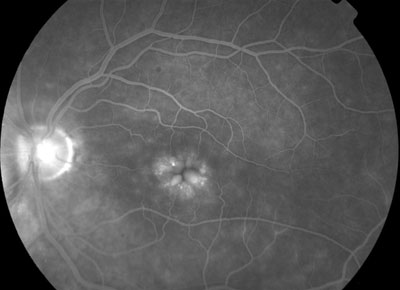 Figure 4. Fluorescein angiography (6 minutes, 22 seconds) demonstrated cystoid macular edema with leakage. |
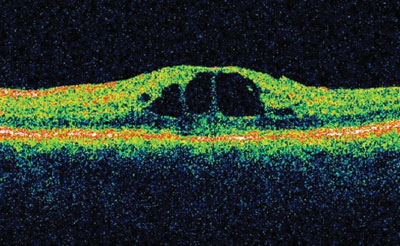 Figure 5. Optical coherence tomography demonstrated cystoid macular edema in the outer plexiform layer of the retina. Subretinal fluid was absent. |
B-scan ultrasonography (Figure 2) demonstrated serous retinal detachment overlying a 4-mm elevated choroidal lesion with high internal reflectivity. A-scan demonstrated a high initial spike corresponding to the anterior tumor surface, followed by a number of spikes throughout the tumor showing high internal reflectivity and acoustic solidarity.
Indocyanine green angiography (Figure 3) showed a well-defined area of early, intense, relatively uniform hyperfluorescence. Fluorescein angiography (Figure 4) demonstrated early lacy filling of the mass during the choroidal phase with diffuse, intense, progressive hyperfluorescent confluence within the mass. Leakage from CME was also seen. Optical coherence tomography (Figure 5) confirmed CME, with a central macular thickness of 498 mm, and a serous retinal detachment overlying the mass.

What is your diagnosis?
Elevated choroidal lesion
The differential diagnosis of a patient with an elevated choroidal lesion with overlying subretinal fluid and concomitant CME includes circumscribed choroidal hemangioma, choroidal metastasis, amelanotic choroidal melanoma, choroidal osteoma, inflammatory choroidal granuloma, nodular posterior scleritis and Harada’s disease.
Differential diagnosis
Circumscribed choroidal hemangioma (CCH) can closely resemble other benign and malignant conditions of the choroid. Clinically, CCHs predominantly have a distinctive orange-red color similar to the surrounding choroid, are located in the posterior pole and are almost always solitary and unilateral. By contrast, amelanotic melanomas are a more yellow-tan color, commonly with overlying drusen. Choroidal metastases generally appear as a creamy-yellow plateau or elevated mass and are frequently bilateral or multifocal. Specifically, choroidal metastatic renal cell carcinoma, thyroid carcinoma and carcinoid tumor can appear orange. For this reason, CT imaging of the chest and abdomen should be considered in patients with choroidal masses. Choroidal osteoma can have a similar color to CCH, but the lesion is almost never elevated. Harada’s disease is characterized by bilateral exudative uveitis, primarily in the posterior segment of the eye, accompanied by pleocytosis of cerebrospinal fluid.
Ancillary studies are helpful to distinguish different types of choroidal masses. On B-scan ultrasound, CCH has a solid acoustic appearance similar to the choroid, and A-scan has characteristically high internal reflectivity. By contrast, amelanotic choroidal melanomas appear relatively sonolucent, and metastatic carcinoma show typical medium to medium-high internal sono-reflectivity. Choroidal osteoma characteristically shows ossification within the choroid on ultrasound, seen as areas of very high reflectivity with underlying paucity of ultrasound signal, even with the gain turned down.
Fluorescein angiography of choroidal hemangioma characteristically shows lacy hyperfluorescence in the choroidal or early arterial phase, with progressive hyperfluorescent confluence of the lesion, as seen in our patient. Appearance of hyperfluorescence in both choroidal melanoma and metastasis is slower.
Indocyanine green angiography of CCH shows a well-defined, early, intense, uniform hyperfluorescence that transitions to an ill-defined, late hypofluorescence, or “dye washout” of the tumor. Filling on indocyanine green angiography is slower and less intense for choroidal melanoma or metastasis.
Given the presence of CME, its distant macular location relative to the nasal choroidal mass and the concomitant presence of vitreous cell, a systemic workup for inflammatory choroidal granuloma was undertaken by the referring ophthalmologist, including Mantoux purified protein derivative, chest X-ray, complete blood count with differential, elevated sedimentation rate, angiotensin-converting enzyme, serum lysozyme, toxoplasmosis titers, Bartonella titers, Lyme titers, rapid plasma regain and fluorescent treponemal antibody. These tests were negative, and the presence of anterior vitreous cell may be explained by the patient’s remote history of cat-scratch disease. A CT scan of the chest and abdomen was also performed to search for any primary sources of metastasis. This testing was also negative, and the patient was presumed to have a circumscribed choroidal hemangioma.
Treatment
The tumor was treated at presentation with Visudyne (verteporfin, Novartis, QLT) photodynamic therapy. At 8 weeks, subretinal fluid, tumor size and CME (central macular thickness of 333 µm on OCT) were reduced, with improvement of BCVA to 20/50. Eight weeks after therapy, no further improvement in CME or BCVA was achieved. PDT of the tumor was repeated. After 5 months of observation, further reduction of the tumor and reduction of subretinal fluid were observed, but with no further improvement of the CME or BCVA. Focal argon green laser (108 applications, 190 mW, 200 µm spot size, 0.2 seconds) was applied to the tumor. At 7 months follow-up, the tumor appeared flat with overlying retinal pigment epithelium changes, with complete resolution of subretinal fluid. CME was significantly reduced (central macular thickness of 292 µm), and BCVA was improved to 20/25.
Discussion
Circumscribed choroidal hemangioma is a rare, benign vascular hamartoma of the posterior pole. CCH presents as a discrete, smooth, orange-red mass with relatively indistinct margins. While thought to be congenital, visual symptoms typically manifest in adulthood secondary to exudative retinal detachment or CME, and are historically associated with poor long-term visual acuity.
While local subretinal fluid most commonly accounts for visual symptoms in CCH, CME may also play a prominent role. In a recent prospective study of visually symptomatic eyes with CCH, 48% had pretreatment CME. However, it is likely that in most cases this represents CME local to the hemangioma, as most lesions reported were either macular (68.9%) or in the peripapillary area (37.9%), with a minority further from the macula in a temporal location (17.2%).
Unusually, our case involved a nasal CCH with the development of symptomatic CME. Nasal CCHs are rarely reported, presumably because they do not typically induce visually significant changes in the macula.
PDT has been shown to be an effective treatment for symptomatic hemangioma, and reports have demonstrated resolution of exudative subretinal fluid and associated CME and improved visual outcome. Argon laser photocoagulation, transpupillary thermotherapy and xenon arc have all been used, but recurrences are common and may induce scarring of the fovea in central tumors.
Interestingly, in our case, PDT and argon laser application overlying the nasally situated tumor not only resulted in regression of the tumor and local subretinal fluid, but in resolution of the distant CME, resulting in significant vision recovery.
References:
- Arevalo JF, Shields CL, Shields JA, Hykin PG, De Potter P. Circumscribed choroidal hemangioma: characteristic features with indocyanine green videoangiography. Ophthalmology. 2000;107(2):344-350.
- Boixadera A, Garcia-Arumi J, Martinez-Castillo V, et al. Prospective clinical trial evaluating the efficacy of photodynamic therapy for symptomatic circumscribed choroidal hemangioma. Ophthalmology. 2009;116(1):100-105.
- Mashayekhi A, Shields CL. Circumscribed choroidal hemangioma. Curr Opin Ophthalmol. 2003;14(3):142-149.
- Ryan SJ. Retina. 3rd ed. St. Louis: Mosby; 2001:838.
- Shields CL, Materin MA, Marr BP, Mashayekhi A, Shields JA. Resolution of advanced cystoid macular edema following photodynamic therapy for choroidal hemangioma. Ophthalmic Surg Lasers Imaging. 2005;36(3):237-239.
- Shields JA, Shields CL, Materin MA, Marr BP, Demirci H, Mashayekhi A. Changing concepts in management of circumscribed choroidal hemangioma: the 2003 J. Howard Stokes Lecture, Part 1. Ophthalmic Surg Lasers Imaging. 2004;35(5):383-394.
- Yanoff M, Duker JS, Augsburger JJ. Ophthalmology. 2nd ed. St. Louis: Mosby; 2004:997.
- Bryan K. Monson, MD, and Jay S. Duker, MD, can be reached at New England Eye Center, Tufts University School of Medicine, 750 Washington St., Box 450, Boston, MA 02111; 617-636-4219; fax: 617-636-4866; website: www.neec.com.
- Edited by Mark E. Patron, MD, and Andre J. Witkin, MD. Drs. Patron and Witkin can be reached at New England Eye Center, Tufts University School of Medicine, 750 Washington St., Box 450, Boston, MA 02111; 617-636-4219; fax: 617-636-4866; website: www.neec.com.

